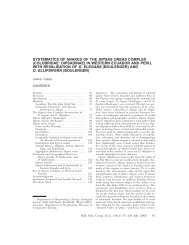cryptic species within the dendrophidion vinitor complex in middle ...
cryptic species within the dendrophidion vinitor complex in middle ...
cryptic species within the dendrophidion vinitor complex in middle ...
You also want an ePaper? Increase the reach of your titles
YUMPU automatically turns print PDFs into web optimized ePapers that Google loves.
SPECIES IN THE DENDROPHIDION VINITOR COMPLEX N Cadle 185<br />
some of <strong>the</strong> characters particularly useful<br />
for <strong>the</strong> three <strong>species</strong> covered <strong>in</strong> this paper.<br />
Dorsocaudal reductions were recorded as<br />
<strong>the</strong> subcaudal at which <strong>the</strong> reduction from<br />
eight to six dorsal scale rows on <strong>the</strong> tail<br />
occurred (Lieb, 1988). The po<strong>in</strong>t of posterior<br />
reduction of <strong>the</strong> dorsal scales was<br />
scored on each side of selected specimens<br />
as <strong>the</strong> ventral scute number at which <strong>the</strong><br />
reduction occurred and <strong>the</strong> dorsal rows<br />
<strong>in</strong>volved. For purposes of analyz<strong>in</strong>g <strong>in</strong>traspecific<br />
differences <strong>in</strong> mean snout–vent<br />
length (SVL) of adult males and females,<br />
specimens with SVL . 450 mm were<br />
considered adults (Goldberg, 2003; Stafford,<br />
2003). Similarly, because relative tail<br />
length <strong>in</strong>creases proportionally with SVL,<br />
<strong>the</strong> range of adult relative tail length (RTL)<br />
was assessed for <strong>in</strong>dividuals with SVL .<br />
300 mm because analyses showed that RTL<br />
approaches an asymptote at approximately<br />
this size. When measurements or meristic<br />
data for particular specimens are referred to<br />
<strong>in</strong> <strong>the</strong> text, <strong>the</strong>se data are based on my<br />
exam<strong>in</strong>ations (data encountered <strong>in</strong> <strong>the</strong><br />
literature sometimes differ).<br />
Intraspecific mean differences between<br />
male and female sizes and scale counts were<br />
tested for significance us<strong>in</strong>g t tests after<br />
test<strong>in</strong>g for homogeneity of variances. P-<br />
values reported for <strong>in</strong>traspecific comparisons<br />
are two-tailed pairwise comparisons; <strong>in</strong><br />
<strong>the</strong> few cases <strong>in</strong> which <strong>the</strong>re was a priori<br />
expectation for one sex or <strong>the</strong> o<strong>the</strong>r to have<br />
a greater value for a character (e.g., males<br />
hav<strong>in</strong>g a longer tail or more subcaudals than<br />
females), p-values for one-tailed tests did<br />
not differ from <strong>the</strong> two-tailed comparison.<br />
Similar procedures and two-tailed tests<br />
were used for <strong>in</strong>terspecific comparisons,<br />
which were analyzed separately for each sex<br />
except <strong>in</strong> cases <strong>in</strong> which <strong>in</strong>traspecific sexual<br />
differences were nonsignificant (sexes<br />
pooled <strong>in</strong> <strong>the</strong>se cases). Means, standard<br />
deviations, and results of <strong>in</strong>traspecific statistical<br />
comparisons for most meristic counts<br />
are presented <strong>in</strong> Table 1, and only summaries<br />
are given <strong>in</strong> <strong>the</strong> text.<br />
For determ<strong>in</strong><strong>in</strong>g tail breakage frequencies,<br />
I counted as ‘‘broken’’ only tails with a<br />
clearly healed cap on <strong>the</strong> stump; thus, I<br />
record <strong>the</strong> frequency of ‘‘broken/healed’’<br />
tails. In my survey of literature, it was<br />
apparent that some authors <strong>in</strong>cluded any<br />
specimens with a tail fracture <strong>in</strong> <strong>the</strong>ir tail<br />
breakage frequency calculations (e.g., at<br />
least one paper recorded multiple fracture<br />
po<strong>in</strong>ts <strong>in</strong> a high percentage of specimens).<br />
However, this method artificially <strong>in</strong>flates<br />
estimates of tail breakage frequencies because<br />
of <strong>the</strong> <strong>in</strong>clusion of snakes whose tails<br />
were broken dur<strong>in</strong>g or after capture, or<br />
even subsequent to storage <strong>in</strong> a museum jar.<br />
Although <strong>the</strong>se specimens may offer clues<br />
as to <strong>the</strong> fragility of <strong>the</strong> tail <strong>in</strong> a particular<br />
<strong>species</strong>, <strong>the</strong>y are not especially useful for<br />
comparative purposes.<br />
I scored <strong>the</strong> number of keeled dorsal<br />
scale rows on <strong>the</strong> neck, at midbody, and just<br />
anterior to <strong>the</strong> vent. Keels <strong>in</strong> all <strong>species</strong> of<br />
Dendrophidion are best developed (i.e.,<br />
encompass<strong>in</strong>g more dorsal rows) on <strong>the</strong><br />
posterior body, but <strong>the</strong> number of keeled<br />
rows on <strong>the</strong> neck or at midbody often show<br />
<strong>in</strong>terspecific differences that provide discrim<strong>in</strong>at<strong>in</strong>g<br />
characters. The three <strong>species</strong><br />
covered <strong>in</strong> this paper are similar <strong>in</strong> <strong>the</strong>ir<br />
patterns of keel<strong>in</strong>g. The basic pattern of<br />
temporal scales <strong>in</strong> D. <strong>v<strong>in</strong>itor</strong> and <strong>the</strong> new<br />
<strong>species</strong> here described is 2+2 (two primary,<br />
two secondary). However, temporal scales<br />
were often divided by a vertical suture<br />
(usually divid<strong>in</strong>g <strong>the</strong> scale asymmetrically),<br />
or, less commonly, two temporal scales were<br />
fused or a temporal was fused with a<br />
supralabial. I recorded <strong>the</strong>se divisions or<br />
fusions separately from <strong>the</strong> basic pattern.<br />
For example, a specimen might be recorded<br />
as hav<strong>in</strong>g 2+2 temporals but with <strong>the</strong> upper<br />
primary and upper secondary fused on one<br />
side. Because of frequent asymmetry, temporal<br />
scales and supra- and <strong>in</strong>fralabials were<br />
scored on each side of a specimen, and each<br />
side was treated as an <strong>in</strong>dependent observation;<br />
<strong>the</strong> total count of observations for<br />
<strong>the</strong>se scale characters (Table 1) is thus<br />
about twice <strong>the</strong> number of specimens<br />
exam<strong>in</strong>ed (damage sometimes prevented<br />
scor<strong>in</strong>g on one or both sides of a given<br />
specimen).<br />
Bullet<strong>in</strong> of <strong>the</strong> Museum of Comparative Zoology harv-160-04-01.3d 11/4/12 19:58:33 185







